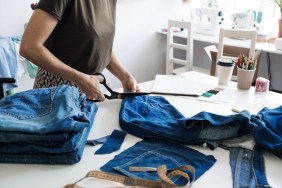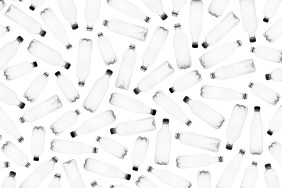On the outside, the fashion industry looks like all fun and games, but there’s a dark side to the business. By now, you’ve heard of the unethical labor practices — child workers, sweatshops and unbearably low wages — but did you also know that the industry is ranked as a major source of pollution in the world, right up there with oil, agriculture and paper? According to the Natural Resources Defense Council, the Chinese textile industry, which produces about half of the clothes Americans buy, creates about 300 tons of soot each year. And a single mill in China can use 200 tons of water for each ton of fabric it dyes. Yikes! It’s time we clean things up. In celebration of Earth Day on April 22, we’re taking a good hard look at our closets to see how we can be the change we want to see in the world. Want to get in on the action? Here are 11 eco-friendly fashion tips to help make your wardrobe more green.
Wash with care
Buy green laundry detergent. It does the same job without the harsh, synthetic chemicals that harm the environment and pose health hazards. To save energy, wash on low heat and line dry.
If you need to dry clean your clothes, search for an eco-friendly, organic cleaner in your neighborhood that doesn’t use perchloroethylene (perc), a common chemical used by many traditional dry cleaners. It’s been listed as a hazardous air pollutant by the Clean Air Act and a probable human carcinogen by the International Agency for Research on Cancer and the US Environmental Protection Agency.
Discard responsibly
According to the EPA, more than 25 billion pounds of clothing and household textiles were generated in the U.S. in 2009. Currently, more than 21 billion pounds are discarded in U.S. landfills. That’s about 70 pounds of clothing and household textiles per person each year. To cut down on waste, try not to throw away your clothes when you’re through with them. Instead, hold a swap meet with your friends or take them to secondhand shops and charitable organizations like Goodwill, The Salvation Army and Dress for Success.
Buy vintage
Buying secondhand isn’t just a thing the cool kids do. It’s also another way to decrease your global footprint. For gently-used designer wares, check out sites like SnobSwap, The RealReal, 1stdibs, Portero and eDrop-Off.
When in doubt, DIY
Give old, tired or discarded clothes and accessories a second life with a little bit of love and a whole lot of DIY magic. You can get crafty with just about anything, from loose bits of jewelry and old shoes to bridesmaid dresses and worn-out sweaters.
Bag it
Biodegradable shopping bags aren’t just for the grocery store. Make sure to bring them shopping with you and tell the sales clerk to hold the plastic.
Buy local
Aside from supporting your community, buying locally reduces environmental impact because local businesses can make local purchases, thereby decreasing transportation pollution. Plus, independent businesses are typically small enterprises, so they take up less land and resources. A win-win for everyone.
Skip fast fashion
We know, we know. You love buying a T-shirt for $3. So do we. But guess what? There’s a reason the price tag is so low. The garments are made to fall apart. Retailers like Forever 21 and H&M are dependent on the consumer’s desire for new clothing — and a dress that gets a hole in it after one wash only escalates that desire. Not to mention the fact that many fast fashion chains still institute unethical labor practices. If that’s not enough to deter you, this may: According to the Center for Environmental Health, fast fashion retailers like Charlotte Russe, Wet Seal and Forever 21 are still selling lead-contaminated shoes, belts and purses above the legal amount, even years after signing a settlement agreeing to limit the use of heavy metals in their products.
Learn about brands
When you purchase merchandise from a brand, you’re not just buying a piece of clothing or a statement necklace. You’re also indirectly giving your seal of approval on its labor and environmental practices. If you want to walk the talk, but don’t know where to begin, check out sites like Labour Behind the Label that provide information on many top brands on the market. And check out our list of 19 eco friendly clothing brands we’re obsessed with.
Go faux
Not only does the production of wool, leather and fur harm millions of animals every year, it also contributes to land devastation, air pollution and water contamination. In addition, finished fur is treated with a cocktail of chemicals, like formaldehyde and bleaching agents, that are toxic to humans.
Invest in your shoes
It’s simple: The more you take care of your shoes, the longer they’ll last. You know what that means? Less consumption and waste. As soon as you unwrap your new pair of shoes, take them to a shoe repair shop to add on heel covers and toe treads, so you won’t damage the bottom of your shoes. When the protective covers wear through, it’s time for another visit. Same goes for broken heels, cuts, holes and fades.
Know your fabrics
Bamboo, silk, organic cotton, soy, hemp and lyocell are just a few of the natural, eco-friendly fabrics on the market. Before you shop, it’s best to know the ins and outs of each. For the CliffsNotes version, hop on over to our friends at Green Living. You’ll be a pro in no time.








